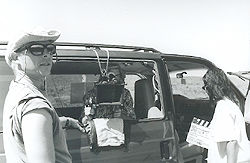
 |
 |
 |
Patrick
Neary
- Director of Photography
What
makes Dog Story different from the typical American crime thrillers?
To me, Dog Story feels like a classic 40's film noir or pot-boiler.
The characters are weather beaten and all of them have some good and some
bad. Roy is definitely the anti-hero.
Were
there any specific visual approaches that you took in shooting this film?
 The
original idea was to light it very naturalistic, but with hard, glossy,
or more artificial edges creeping in. So we might augment the natural
daylight with an HMI through a window, but then give Maria a very artificial
"glam" light. I think that approach helps to remove the story one step
from reality, and creates a very subtle fantasy world that these characters
inhabit. Of course, working fast like we did, with many, many set-ups
and location moves, begins to dictate a certain look. You don't have time
to wistfully ponder each shot or each glint of light in the frame. It
becomes almost gut reaction, instinctive lighting and framing, and then
later you hope your instincts were right! Our gaffer, Milt Riess, kicked
booty on set-ups. We knew the basic look we wanted from pre-production,
and then just did it. I think if the crew knows the core idea or approach,
then you don't get mired in details, or railroaded by the myriad of problems
that crop up on location. You can work around blown circuits and bad weather
and lost locations.
The
original idea was to light it very naturalistic, but with hard, glossy,
or more artificial edges creeping in. So we might augment the natural
daylight with an HMI through a window, but then give Maria a very artificial
"glam" light. I think that approach helps to remove the story one step
from reality, and creates a very subtle fantasy world that these characters
inhabit. Of course, working fast like we did, with many, many set-ups
and location moves, begins to dictate a certain look. You don't have time
to wistfully ponder each shot or each glint of light in the frame. It
becomes almost gut reaction, instinctive lighting and framing, and then
later you hope your instincts were right! Our gaffer, Milt Riess, kicked
booty on set-ups. We knew the basic look we wanted from pre-production,
and then just did it. I think if the crew knows the core idea or approach,
then you don't get mired in details, or railroaded by the myriad of problems
that crop up on location. You can work around blown circuits and bad weather
and lost locations.
We also tended to stick with either the wide end of the Zeiss zoom (10mm)or the telephoto end (100mm), and ignoring the focal lengths in between. This helped again to stylize the film and give it a consistency, but in a way that is not brash or distracting. We played with the dog's POV a bit, too. The beginning sequence is all dog-POV, along with several other sequences throughout the film. The dog's-eye-views were all somewhat loose; we were trying to mimic an easily-distracted pooch, so the camera was all over the place.
What
camera did you shoot it on? What stock? Filter?
We shot Dog Story with a simple, 16mm Arri SR-1 package, running
Kodak's Vision 200-T (7274) negative stock. I'm a total simplicity fanatic,
so I like to stick with one stock throughout a production, and the 200-T
is the perfect balance of speed and grain structure. We also shot everything
through an 81EF warming filter ( in addition to the 85 daylight correction)to
romanticize our exteriors a bit. LaGrande in August is a fairly brown
landscape, and the filtration helped to play off that. We also used a
hand-held Canon Scoopic for a few doggy-POV shots.
Our lighting package consisted of two small HMI's (575 and 1200 watt) and an assortment of 2k, 1k and inky fresnels. Our grip truck - man, I hope there's a picture of our grip truck on the site. Matt, the sound mixer, called it "The Beverly Grip-Billies".
festivals . film stats . music . links . poster . contact us
